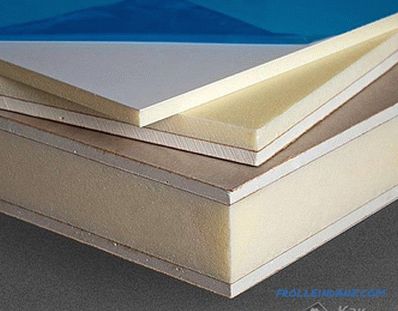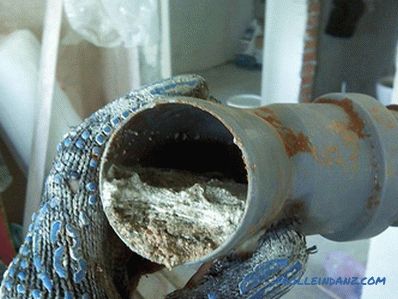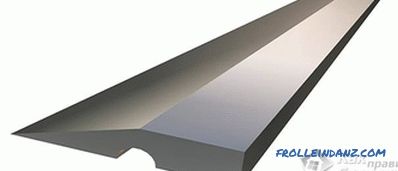The most warm and ecological houses are wooden buildings, namely, log houses. As you know, wood saves well and accumulates heat, so the walls of the house are also endowed with these important properties. There are many statements that the thermal conductivity of a wooden wall, which is only 24 cm thick, is equal to the thermal conductivity of a brick wall with a thickness of about 1 m. And this is really impressive. Nevertheless, it happens that during the operation you notice that in the winter period your house is not as warm as you would like, and sometimes it happens, even drafts are walking. In this case, you need to think about how to warm your home and remove all the cold bridges, so that the heat is kept inside and the house is well insulated. We can say that in the harsh regions every room needs warming. Therefore, we will further consider with you how to insulate a log house, what exactly it is necessary to insulate, what materials are better suited for this purpose, and also consider in detail the steps for performing insulation work.
Why is it cold in a log house
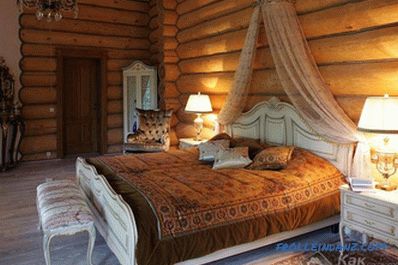 It can be cold inside
It can be cold inside
Before how to begin to fight the cold, you need to determine its source. Although the tree is warm enough and accumulating material, it can be cold in such a house in winter. Why? The owners of log buildings often encounter such problems:
- Frequent drafts in the rooms.
- It is cold in the legs because of the wind blowing over the legs.
- After turning off the heating system, the house begins to cool quickly.
- Cold walls.
There are some more different nuances that we will not mention. Yet this is enough to think about the urgent warming of the house. Let's take a look at what happens in the house when it is heated. For example, you have a log house, which you heat with any heat source, whether it is gas heating or electric. In the heat exchange at home participate:
- heat source;
- indoor air;
- ceilings;
- walls;
- floor .
How does everything work? From the school course of physics, we know that the air heated by the heat source begins to rise up to the ceiling. When it rests on its surface, there is a transfer of heat, in which air is cooled. What is the result? The most heated and warm part of the house is the ceiling. Now the air is directed to the walls, going down on their surface. Please note that the walls are much colder than the ceiling due to the external influence of frost, so the air begins to cool faster, increasing its speed of movement. Further, the air flow goes to the floor, while gaining sufficient acceleration, moves along its surface with such speed that it seems to you that there is such a draft on the legs that there are no walls at all. Moreover, if a heat source, such as a portable radiator or a fireplace, is installed directly near the interior walls, as is often done, the speed of the flow will increase even more. It turns out that there is a constant draft in the rooms, which is caused by the owners themselves.
 Movement of warm air inside the house
Movement of warm air inside the house
To avoid this, special building codes were created, according to which Heating radiators should be placed under the windows. It is clear that the outer walls themselves are cold, while the walls inside are quite satisfactory. It turns out that when the heat source is located under the battery, the warm air prevents the penetration of cold, and also, rising and falling on the walls, will not cool down so fast and move quickly. Why? The air flow will descend down the inner walls, which are much warmer, and when it goes down the outer wall, it will collide back with a source of heat that will heat it, repeating the whole cycle. In this scenario, it turns out the following: the house warms up much faster, and the whole structure keeps heat better, because it is not wasted, but accumulates.
But this is not the only reason why it can be cold in the house. Often heat loss occurs due to poor insulation and cold bridges. To eliminate heat loss, you need to check:
- Ceiling. The first thing you need to check it is, because it is through the ceiling that up to 70% of the total heat goes. It is important for you to keep the heat in the house and to warm the attic or attic.
- Walls. All external walls and the elements in them, such as windows and doors, account for the lion's share of heat loss. Incorrectly installed doors or windows are the first reason why the house can be cold. Warm air will simply leave the room, and cold air will fill it. Heating the room will be very difficult. Moreover, the cracks in the walls also lead to this effect.
- Paul. This is the last source of cold in your home. It must be in good condition and insulated.In winter, reduce the ventilation of the subfloor.
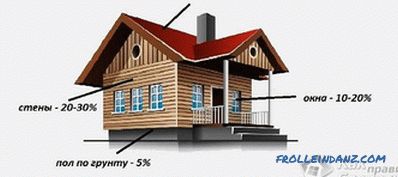 House heat losses
House heat losses
Next we will look at how to get rid of these problems and reduce them to minimizing heat loss through the ceiling, walls and floor. Let's find out what and how to properly warm a log house.
Requirements for insulation materials
Thanks to the insulation of the house, you can reduce heat loss, while the costs for heating the room will be significantly reduced. This will make your stay much more comfortable. We offer you to remember what and how our grandfathers and great-grandfathers insulated a log cabin. In their arsenal there were various materials that allowed to insulate the walls of the building. It was also the so-called "dauber", consisting of straw mixed with clay, as well as shingles from wood, which plastered the walls. This simple way helped residents solve the problem of drafts, moreover, the walls could still "breathe". It is worth noting that it did not spoil the appearance of the building, it seemed more well-groomed and neat.
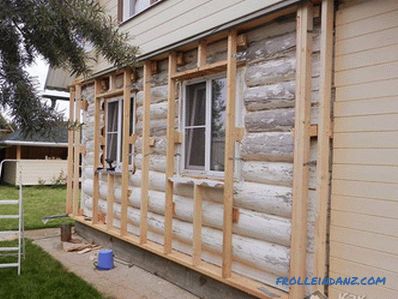 Lathing under insulation
Lathing under insulation
But as time goes on, the construction industry is developing, and the use of such old-fashioned methods already irrelevant. Today we have a lot of insulation materials, which are much more efficient, and it is much easier to work with them. Therefore, before you engage in insulation, you need to familiarize yourself with the properties that such materials should possess. This will help insulate your home properly and 100% efficiently. What qualities should insulating material have? These basic properties are:
- good vapor permeability. It is important that it be the same as that of wood;
- high resistance to moisture. As you know, wood and moisture are incompatible concepts, so insulation should not accumulate condensate so that wood does not rot;
- material must breathe, letting air easily;
- high fire resistance to keep the house from fire ;
- it should fit closely to the rounded structure of the wall and fill the gaps.
Taking into account all these recommendations, you can choose the insulation that will perform its functions qualitatively. But the question arises, how to insulate a log house? Now we consider the ideal options for warming the house of wood.
What to use
As mentioned earlier, the whole process of warming comes down to warming the attic or ceiling, caulking the walls, warming the door and window frames and the floor. If you perform all these procedures correctly, no additional work will be required.
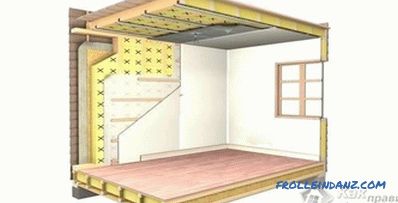 Scheme of insulation of a log house
Scheme of insulation of a log house
It is worth noting that the most common reason for building a house of wood is that this is a natural and environmentally friendly material, so it’s foolish to talk about using foam for its insulation, because then the whole point will be lost. Moreover, it does not fit in its properties with those that are recommended. What then to use?
To insulate the attic, experts recommend using these materials:
- sawdust;
- cellulose cotton wool (ecowool);
- straw;
- seaweed;
- mineral wool.
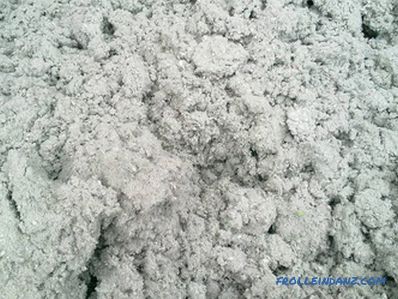 Ecowool
Ecowool
If we talk about caulking of walls, then it should be done only from natural materials:
- moss;
- tow;
- hemp;
- jute;
- heat insulation based on jute and flax.
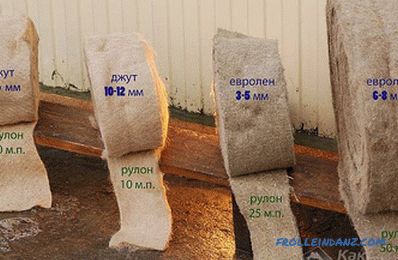 Materials for caulifiers
Materials for caulifiers
The main requirement for materials is the similarity of their properties with the properties of wood .
To warm the wooden floor on the logs, use mineral wool rolls or natural backfill materials. As for the floor of concrete, then it requires a more dense material. This may be:
- cork;
- basalt wool in slabs whose density must exceed 160 kg / m 3 ;
- polystyrene foam;
- extruded polystyrene foam.
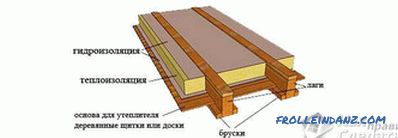 Floor insulation scheme in a wooden house
Floor insulation scheme in a wooden house
It happens that even after doing all These basic indoor procedures may be cold. Why and what to do? The reason may be that during the construction the thickness of the logs was chosen incorrectly. It is also not necessary to exclude the fact that the house is already old or incorrectly calculated the heating. In any case, you have to warm the walls. Taking into account all the requirements for home insulation, you can use
- Ecowool for wall insulation outside.
- Sawdust or sawdust-pellets (backfill material).
- Mineral wool.
- Expanded clay (backfill).
Wood is not a simple building material, because it is not only able to "breathe", but is also considered a kind of air recuperator. When air enters the thickness of the tree across the fibers, then it is distributed along these fibers, leaving through the end. It turns out that the tree "breathes" through the ends.That is why for such "living" walls can not be used:
- Foam.
- Polyurethane foam.
- Extruded polystyrene foam.
- Mounting foam to eliminate gaps.
- Various sealants.
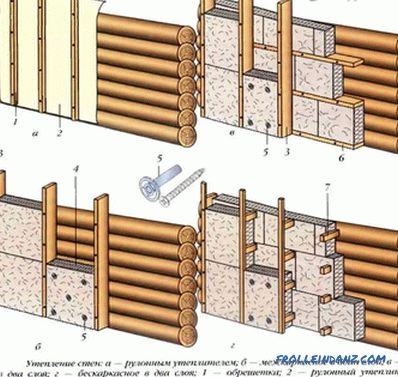 Thermal insulation of log walls outside the scheme
Thermal insulation of log walls outside the scheme
If you ignore this advice, such vapor-proof materials will contribute the fact that during operation the tree will simply rot. And if you protect the wood from the inside with a vapor-proof film, the whole chopped house will turn into a thermos.
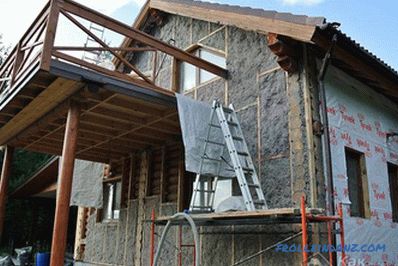 Warming the walls outside with ecowool
Warming the walls outside with ecowool
Ceiling
For a start, it is important to do everything to insulate your home from the inside. We found out that the lion’s share of all the heat goes through the ceiling, so the first thing to do is to warm the house with it. Many are not quite responsible attitude to this event, and do not always want to warm the ceiling. Nevertheless, the fact that warm air always rises upwards is undeniable, and if the top is not insulated, then it (the air) will simply go outside. Believe me, all the money spent on insulation will pay off completely, since you will save a lot on heating.
So, what do you need to insulate the ceiling? These tools are:
- knife;
- hammer;
- hacksaw;
- electric jigsaw;
- screwdriver;
- tile adhesive.
In order to build the casing and frame, prepare:
- nails or screws;
- glue;
- cut board;
- assembly foam;
- drywall.
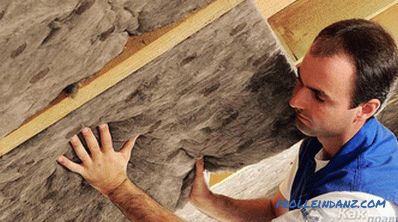 Warming the attic ceiling
Warming the attic ceiling
As for the material for insulation, it is better to use ecowool or mineral cotton wool. If we talk about mineral wool, it is a relatively inexpensive material, which is distinguished by its positive qualities. Mineral wool does not burn, has a tensile strength, has sound-proofing properties and is easy to work with, so even a beginner will be able to complete the installation on his own, without any help. And in order to ensure good waterproofing, we recommend to use asphalt.
Having prepared all the necessary tools and materials, you can get to work. The whole process can be divided into the following steps:
- The first step is to make a frame from a cut board. Please note that this will affect the height of the ceilings. For those who are high, it will even benefit. Boards need to be fixed in increments of no more than 1 m from each other.
- To ensure good waterproofing, the space between the boards must be filled with glass brick so as not to leave empty seats. The material should hold well, for this a little grease it with tile glue.
- Now lay mineral wool on top of the glassine. Make sure that the insulation is well adjoined to each other, leaving no gaps and holes. In the case when mineral wool does not want to hold, apply a small amount of tile glue on it.
- After the whole ceiling is insulated, it must be sheathed with plasterboard to give a complete look. Using self-tapping screws and a screwdriver, drywall sheets are screwed to the frame.
That's it, your ceiling is insulated. It remains only to trim the ceiling and make the lining. Now the precious heat will remain in your room, which will reduce your heating bills.
In order for the insulation work not to go to ashes and be performed correctly, it is important to carry them out during the warm period. Moreover, it is impossible to carry out warming of a log house immediately after its construction. The building needs about a year to shrink. Given this, the work should be carried out not earlier than 1 year after its construction.
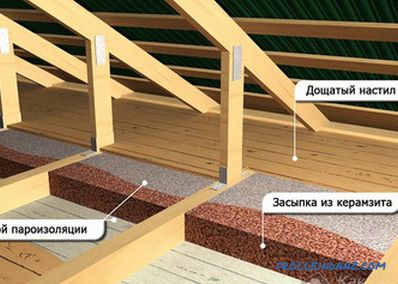 Insulation with expanded clay of the ceiling of an unheated attic
Insulation with expanded clay of the ceiling of an unheated attic
Do not do without roof insulation, so if you have an attic, it should also be insulated.
Walls
When you decide to insulate the walls inside the house, you must take into account that condensation will form on the walls. This will be especially a problem for those who live in northern places where winters are very cold. Condensate arises due to a sharp temperature drop: it is very cold outside the house and warm inside. It turns out that the dew point will move to the layer of insulation. But this is not a problem, since everything can be fixed with a simple vapor barrier film, which is often used with insulation. Another option is to perform good ventilation.
To do the work, you will need:
- tape measure;
- plumb;
- screwdriver;
- level;
- chisel;
- hammer drill;
- electric jigsaw;
- mallet;
- hammer;
- dowels and screws;
- screwdriver;
- felt, tow or foam;
- wooden bars;
- insulation, drywall and putty.
We recommend using ecowool as a heater for walls (mineral wool can be used instead).The advantage of the material is that it fills in the walls all the cracks and voids, preventing them from blowing. It is worth noting that the moisture does not penetrate inside, so the fungus you are not afraid. Among other things, it is a breathable material.
Now we will start the technology of wall insulation.
- If there are cracks or gaps in the wall, they should be sealed with foam, tow or linen felt. Choose what you like and what is easier to work with.
- Make a crate of the wooden beam. Mark the place where the extreme elements of the batten will be installed. Pay special attention to this work, since the fixing of the following elements will depend on the correct installation of the first bars. That's why you need to use plumb lines and level.
- If you have located the first beam, you need to fix it with dowels and screws. To secure the timber to the wall, fasten it in steps of 25-30 cm.
- Place the following bars with a space of 1 m from the previous one, parallel to it. Thus, you will make a frame around the perimeter of the wall. When there is a window opening on the way, it should be upholstered with parallel bars in a circle.
- Now you need to mount intermediate bars. On top of the first vertical bars screw the intermediate bars, which will be in a horizontal position. Your wall should be divided into squares. To prevent fungus and decay, treat wood with antiseptic.
- Your crate is ready, it remains to lay a layer of insulation between the bars. In this case, no need to use glue. Ecowool will keep well between the wall and crate, the main thing is to place it tightly.
- At this stage, you should make a vapor barrier using plastic wrap. Lay it on top of the insulation with a small overlap of 5-10 cm.
- And in the end you need to do the finishing. Wall sheathe drywall, screwing it to the crate. Plates should fit snugly together. All cracks are required to be puttied.
Floor
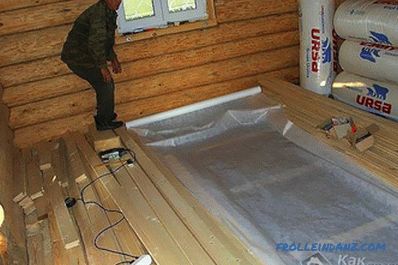 Installation of insulation on the floor
Installation of insulation on the floor
The last thing should be insulated in your log house - this is the floor. To work you need such tools and materials:
- drill;
- hammer;
- electric jigsaw;
- saw or handsaw;
- knife, pencil and nails;
- tape measure and level;
- plane;
- insulating material (mineral wool).
When you have a concrete floor in your house, its warming is simply necessary. Work, of course, is not easy, but following the instructions, spending a little time and effort, you can do it.
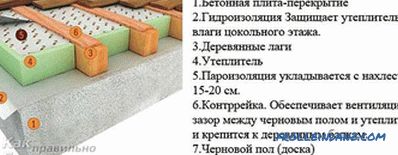 Warming of a concrete floor scheme
Warming of a concrete floor scheme
One of the methods of floor warming is called “raised floor”. Works are reduced to raising the floor by 6 cm and warming it. The work steps are as follows:
- Concrete pavement should be leveled and various defects removed.
- On the concrete surface, lay a waterproofing membrane that will not allow moisture to pass through to the insulation.
- Now you need to lay the logs of the bars. The distance between them should not exceed 50 cm. The recommended size of the lag is 50 * 100 mm, with a thickness of at least 50 mm. Do not apply logs more than 30 cm to the wall. It turns out that your floor should be divided into even lines of bars, which serve as lag.
- Put mineral wool in between the lags. Again, tightly fill the empty space, so as not to leave gaps.
- Place a PVC membrane on the insulation.
- It remains only to lay the flooring, and your warmed floor is ready. The material is good to use chipboard or waterproof plywood.
That's all, your home is well insulated from the inside, and you can enjoy comfortable living in a warm room. As you can see, there is nothing complicated, but what is the result. But besides all this, you can warm your home outside. How to do it? Let's find out.
Caulking of walls
Caulking is one of the most important activities that every log house owner must perform. Thanks to this, you can seal all the gaps and cold air will not penetrate the house. This is the process by which the frame is compacted with fibrous materials. All work must be done in warm and dry weather. What needs to be done?
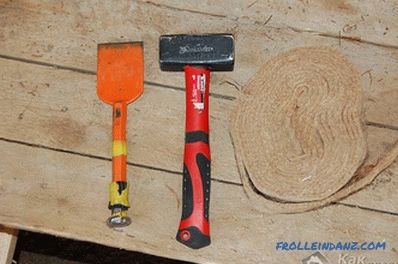 Tools for caulking tools
Tools for caulking tools
To work, you need to prepare:
- hammer;
- scissors;
- chisel;
- gouge;
- kiyanka.
The work on the caulking machine must be carried out first of all, even before any stages of insulation. In addition, the caulker can be performed only after the building has shrunk. All work begins with the lower rims and as you need to move up. It is important to caulk the seams both outside and inside, and one wall cannot be completely processed, then the second. Everything should be evenly and go around the perimeter, otherwise the building may skew.
 Caulking of logs
Caulking of logs
For example, let's consider a caulker with tape insulation or jute. It can be called the simplest. Cutting the tape is unnecessary, which facilitates all the work. So, the process of work is as follows:
- To begin with the first lower crown. Put the end of the tape on the ground and unwind it, gradually moving to the other end. Cut the tape is not necessary, the main thing is to ensure that it goes in a strip and does not turn over. Please note that the material should not be tightly stretched.
- Go to the beginning of the ribbon, lift it and start pushing it between the rims from the butt. As soon as you have finished the first crown to the opposite end, cut the ribbon with a margin of 10-20 cm. Use well-ground scissors.
- Now everything can be caulked securely using a hammer and a caulk. Do this gradually so that no wrinkles form. In one stage, it will not be possible to do everything, so push it in until it is hidden in the log. Need to push through the tape at a slight angle, as if on a diagonal.
- Oddly enough, everything needs to be repeated again, between the same logs. There can hold another 1 or 2 tapes, depending on the gaps and the density of the tape. It turns out that the caulker leaves more material than the initial weatherization of the crowns, and note that this is just the outside. You need to repeat the entire procedure inside and move up along the entire perimeter.
This is a rather scrupulous and long work, but having made it, you seal your structure, and the air will not walk inside the room.
How to caulk a log house, you can see in the video:
Insulation of windows and doors
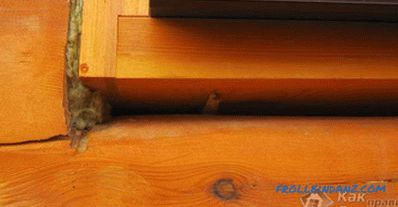 Insulation of windows
Insulation of windows
This is another important stage in the insulation of the house outside, without which it is simply impossible to do. You will be pleased that it will be very easy to seal all the cracks and holes in the window and door frames. For work you need only an aluminum ruler and polyurethane foam, which you need to blow all the gaps.
First, you need to determine the tightness of windows and doors. The aluminum ruler can define slots, pushing it into different parts near the window frame. In those places where she walks freely, cold air enters the house. All such slots should be blown out with assembly foam. In the same way, check the door frames and take all necessary measures.
When you find a gap under the sill, you need to fix it both outside and inside. In windy weather, just take a candle or matches and spend near the window sill. Purging can be noticed by the flame. Eliminate all slots with foam.
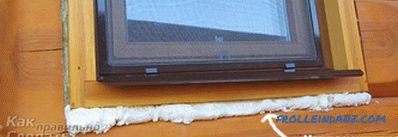 Use soft mounting foam
Use soft mounting foam
Take a look at your windows. If they are old and have lost their original properties, it is worth thinking about putting new ones that will keep the heat in the house much better.
By completing all these activities, or at least some of them, you can solve the problem of heat loss. Your wooden house will keep you warm, thanks to which your stay will be more comfortable. It is also important that your heating costs are reduced. It is not so difficult to do the work, so even without outside help you can cope with the task.
Video
Warm-seam technology is sometimes used to insulate log houses. How is the insulation, see below:
